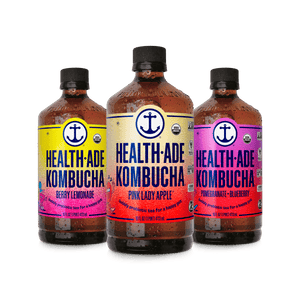
Kombucha | 12 Pack
Fan Favorite Variety Pack
One-time Purchase
49.95

Copied URL to clipboard!
Forty percent of the food produced in the U.S. gets wasted. That means on average, each of us is tossing about 300 lbs of perfectly good food every year, which is not only a waste of money and hard work, but also a huge stress on the environment.
For every pound of wasted food, we’re also wasting the water and energy put into growing, packaging and transporting that food, as well as contributing significantly to global warming, since food is the number one thing found in landfills (which lets off methane gas during decomposition).
Luckily, it’s easy to waste less food!
Here are 5 simple yet effective ways to get started:
This is a game-changer. Before making a grocery list I thoroughly survey my pantry, fridge and freezer. I really dig in, unearthing buried bags of frozen peas and year-old cans of coconut milk. Not only does this prevent me from buying things I already have that I may have forgotten about, it begins my meal idea inspiration.
If I find a bag of dry lentils, a can of tomatoes, half an onion and a few carrots – I discover I can make my family’s favorite soup without even having to buy anything. This helps us stick to our food budget and satisfies my desire to feel efficient.
I used to buy hummus every week, because I enjoy it and thought my kids would snack more on veggies if a tasty dip was available. But recently, I realized I was throwing away half-full hummus containers as fast as I was buying them - despite the fact that we all like it.
So I stopped buying hummus, unless it’s for a specific meal, and calculated that I’m saving about $20 month on groceries just from that one change, in addition to throwing away less food. To determine which foods you’re tossing most often, keep a running list of everything you throw away for a whole month. At the end of the month, see what the patterns are and shift your buying habits accordingly.
It’s easy to get caught up in over-ordering when you’re with a group of people, but I’ve found that if I order less, the people around me feel more comfortable doing it too - and still no one leaves hungry.
It’s part of human nature to gather and store stuff, but most of us do it so well that we end up buying more than we could ever use. Next time you head to the store, make a list. Think hard about how much of each item on the list you really need. Do you really eat all the carrots in the bag, or would a few loose carrots work?
Will your family really drink a whole gallon of milk, or will a quart be enough for morning cereal? It may feel uncomfortable at first to slim down what you buy, but after a few weeks it will feel normal - and your wallet will thank you!
A VANILLA-RASPBERRY KOMBUCHA FLOAT